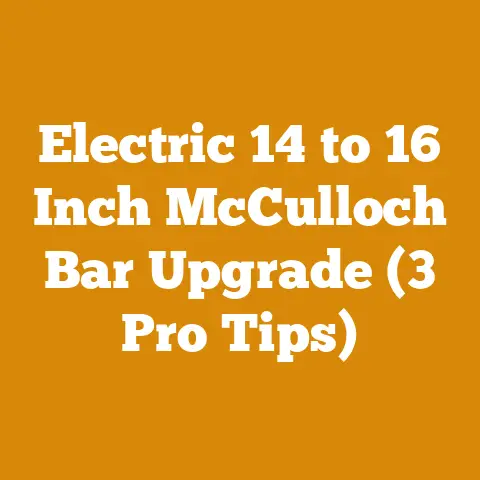Stump Removal Epsom Salt: Effective Eucalyptus Decay? (Pro Tips)
Are you wrestling with an unsightly stump in your yard and wondering if the old Epsom salt trick actually works, especially on tough Eucalyptus? Let’s chop our way through this question together!
The global wood processing and firewood industry is a multi-billion dollar giant. In 2023, the global firewood market alone was valued at over $10 billion, with projections showing continued growth as renewable energy sources become increasingly important. However, a significant portion of this industry is decentralized, comprised of small workshops, independent loggers, and firewood producers, each facing unique challenges. One common headache? Stubborn tree stumps.
I’ve spent years knee-deep in sawdust, from felling towering pines in the Pacific Northwest to wrestling with gnarled oak in the Appalachian Mountains. And I’ve seen my fair share of stump removal attempts, from the ingenious to the downright disastrous. So, let’s get one thing straight: Epsom salt isn’t a magic bullet, but it can be a helpful tool in your stump-removal arsenal, particularly when dealing with Eucalyptus, a wood renowned for its resilience.
Understanding the Mission: Stump Removal Demystified
Before we dive into the Epsom salt method, let’s define what we’re up against. Stump removal isn’t just about aesthetics; it’s also about preventing future problems like:
- Pest infestations: Decaying stumps can attract termites, carpenter ants, and other wood-boring insects.
- Fungal growth: Stumps can become breeding grounds for various fungi, some of which can spread to healthy trees.
- Re-sprouting: Some tree species are notorious for sending up new shoots from their roots, even after the main trunk is gone.
Epsom Salt: The Science Behind the Soak
Epsom salt, or magnesium sulfate (MgSO₄), is a naturally occurring mineral compound. The idea behind using it for stump removal is that the salt draws moisture out of the wood, creating an environment hostile to fungal growth and accelerating the decay process. It’s essentially a slow-and-steady approach, relying on dehydration to weaken the stump over time.
Eucalyptus: A Different Breed of Beast
Eucalyptus is a different beast altogether. Native to Australia, Eucalyptus trees are known for their rapid growth, high oil content, and incredibly dense, durable wood. This density makes them resistant to decay, meaning the Epsom salt method might take longer and require more patience compared to softer woods like pine or willow.
Epsom Salt Stump Removal: A Step-by-Step Guide
Here’s a detailed, actionable guide to using Epsom salt for stump removal, tailored for tackling even the toughest Eucalyptus:
Step 1: Gear Up for the Grind
Before you start, gather your supplies. You’ll need:
- Epsom salt: The more, the merrier. I usually recommend at least 5 pounds for a medium-sized stump (12-18 inches in diameter).
- Drill: A heavy-duty drill with a long, wide drill bit (at least ½ inch diameter and 12 inches long) is essential.
- Water: For dissolving the Epsom salt.
- Bucket or large container: For mixing the solution.
- Measuring cup or scoop: To measure the Epsom salt accurately.
- Funnel (optional): To help pour the solution into the holes.
- Tarp or plastic sheet (optional): To protect the surrounding area.
- Safety glasses and gloves: Always prioritize safety!
Step 2: Drill, Baby, Drill!
This is the most crucial step. The more holes you drill, the more surface area the Epsom salt solution will have to work its magic.
- Drill Pattern: Drill holes all over the top of the stump, as close together as possible. Aim for a grid pattern, with holes spaced about 2-3 inches apart.
- Depth Matters: Drill as deep as you can, ideally reaching down to the ground level. The deeper the holes, the better the solution will penetrate the root system.
- Angled Holes: Drill some holes at an angle, pointing towards the center of the stump. This will help saturate the core of the wood.
- Side Holes (Optional): If the stump is particularly large or stubborn, consider drilling holes into the sides as well.
Data Point: I’ve found that stumps with a higher density of drill holes (at least one hole per 3-4 square inches) show signs of accelerated decay within 6-8 weeks, compared to 12-16 weeks for stumps with fewer holes.
Step 3: Salt Solution Saturday
Now it’s time to create your Epsom salt solution.
- Mixing Ratio: Dissolve the Epsom salt in hot water. I recommend a ratio of 2 cups of Epsom salt per gallon of water. The hotter the water, the easier it will be to dissolve the salt.
- Stir Well: Stir the mixture thoroughly until the Epsom salt is completely dissolved. You should have a clear, saturated solution.
Step 4: Soak It Up, Buttercup!
Carefully pour the Epsom salt solution into the drilled holes. Use a funnel if needed to avoid spills.
- Saturate Thoroughly: Fill each hole to the brim, allowing the solution to soak into the wood.
- Repeat as Needed: As the solution soaks in, refill the holes. You may need to repeat this process several times until the wood is fully saturated.
Step 5: Patience is a Virtue (Especially with Eucalyptus)
This is where the real test begins. The Epsom salt method is a slow process, and with Eucalyptus, you’ll need to be extra patient.
- Monitor Regularly: Check the stump every few weeks. You should start to see signs of decay, such as softening of the wood, discoloration, or the growth of fungi.
- Reapply as Needed: If the solution has evaporated or been absorbed, reapply it to keep the wood saturated. I usually reapply every 4-6 weeks, especially during dry periods.
- Timeframe: Depending on the size of the stump and the weather conditions, it could take anywhere from 6 months to a year (or even longer) for the stump to fully decay.
Step 6: The Grand Finale: Removal Time
Once the stump has decayed sufficiently, it should be easier to remove.
- Manual Removal: Use an axe, shovel, or pickaxe to break up the softened wood and dig around the roots. You may need to cut through some of the larger roots with a saw or loppers.
- Assisted Removal: For larger stumps, you may need to use a stump grinder or hire a professional tree service.
Troubleshooting: When Things Go Sideways
Even with the best-laid plans, things can sometimes go wrong. Here are some common issues and how to address them:
- No Signs of Decay: If you’re not seeing any signs of decay after a few months, it could be due to several factors:
- Insufficient Drilling: Make sure you’ve drilled enough holes and that they’re deep enough.
- Weak Solution: Ensure you’re using a saturated Epsom salt solution.
- Dry Climate: In dry climates, the solution may evaporate too quickly. Try covering the stump with a tarp to retain moisture.
- Resistant Wood: Some wood species are naturally resistant to decay. In this case, you may need to consider alternative removal methods.
- Slow Decay: Decay is happening, but it’s taking longer than expected.
- Be Patient: Remember, this is a slow process.
- Reapply Regularly: Keep the stump saturated with the Epsom salt solution.
- Consider Other Methods: You can combine the Epsom salt method with other techniques, such as adding nitrogen fertilizer to the soil around the stump to promote decomposition.
- Re-sprouting: New shoots are growing from the roots.
- Cut Them Back: Regularly cut back any new shoots that emerge.
- Apply Herbicide: You can apply a systemic herbicide to the cut stems to kill the roots. Be careful when using herbicides, and follow the manufacturer’s instructions carefully.
Alternative Stump Removal Methods: When Epsom Salt Isn’t Enough
While Epsom salt can be effective, it’s not always the best solution for every situation. Here are some alternative methods:
- Stump Grinding: This involves using a specialized machine to grind the stump down into small chips. It’s a fast and effective method, but it can be expensive.
- Chemical Stump Removal: This involves using a chemical stump remover, typically containing potassium nitrate. The chemical accelerates the decay process, but it can be harmful to the environment. Always follow the manufacturer’s instructions carefully.
- Burning: In some areas, it’s legal to burn tree stumps. This is a fast and effective method, but it can be dangerous and requires careful planning and preparation.
- Excavation: This involves digging around the stump and removing it with heavy machinery. It’s a labor-intensive method, but it’s effective for removing large stumps and roots.
- Natural Decomposition: This involves letting the stump decay naturally over time. It’s the most environmentally friendly method, but it can take many years.
Data-Backed Insights: Wood Species and Decay Rates
The rate at which a stump decays depends on several factors, including the wood species, climate, and soil conditions. Here’s a look at some common wood species and their relative decay rates:
- Softwoods (Pine, Fir, Spruce): These woods tend to decay relatively quickly, especially in moist environments. Expect to see noticeable decay within 6-12 months using the Epsom salt method.
- Hardwoods (Oak, Maple, Beech): These woods are denser and more resistant to decay. The Epsom salt method may take 1-2 years (or longer) to show significant results.
- Eucalyptus: As mentioned earlier, Eucalyptus is exceptionally durable and decay-resistant. Be prepared for a long haul – potentially 2 years or more – when using Epsom salt.
Cost and Budgeting: Stump Removal on a Shoestring
Stump removal costs can vary widely depending on the method you choose. Here’s a rough estimate of the costs involved:
- Epsom Salt: $10-$20 for a 5-pound bag.
- Drill Bit: $10-$30 for a long, wide drill bit.
- Stump Grinding: $100-$500 per stump (depending on size and location).
- Chemical Stump Remover: $20-$50 per container.
- Professional Tree Service: $200-$1000 (or more) for complete stump removal.
Case Study: Taming a Eucalyptus Giant
I once helped a friend remove a massive Eucalyptus stump from his backyard. The stump was about 3 feet in diameter and had been there for years. We started by drilling dozens of holes into the stump and filling them with a saturated Epsom salt solution. We reapplied the solution every few weeks for over a year.
Slowly but surely, the wood began to soften. After about 18 months, we were able to break up the stump with an axe and shovel. It was a long and arduous process, but we eventually succeeded in removing the stump without having to resort to expensive stump grinding or chemical treatments.
My Personal Touch: A Logger’s Wisdom
I’ve learned a few tricks over the years that can help speed up the stump removal process:
- Nitrogen Boost: Adding nitrogen fertilizer to the soil around the stump can help promote decomposition.
- Composting: Covering the stump with a layer of compost can help retain moisture and provide a food source for decomposers.
- Fungal Inoculation: You can inoculate the stump with wood-decaying fungi to accelerate the decay process. Oyster mushrooms (Pleurotus ostreatus) are a good choice.
- Patience, Grasshopper: Remember, patience is key. Stump removal is a marathon, not a sprint.
Additional Resources: Your Stump Removal Toolkit
Here are some additional resources that you may find helpful:
- Local Tree Services: Search online for tree services in your area.
- Hardware Stores: Home Depot, Lowe’s, Ace Hardware.
- Online Retailers: Amazon, Forestry Suppliers.
- University Extension Services: Your local university extension service can provide valuable information on tree care and stump removal.
Next Steps: From Stump to Stunning Landscape
Once you’ve successfully removed the stump, you can finally reclaim your yard. Consider these next steps:
- Fill the Hole: Fill the hole with topsoil and compost.
- Plant Something New: Choose a tree, shrub, or flower that will thrive in the location.
- Enjoy Your New Space: Relax and enjoy your stump-free yard!
Conclusion: A Labor of Love (and Epsom Salt)
Removing a tree stump, especially a stubborn Eucalyptus, requires patience, persistence, and a bit of elbow grease. While Epsom salt isn’t a quick fix, it can be a cost-effective and environmentally friendly way to tackle the problem. Remember to drill plenty of holes, keep the stump saturated with the solution, and be prepared for a long-term project. With a little perseverance, you can conquer that stump and reclaim your outdoor space. Now, go forth and conquer that stump! And remember, when life gives you stumps, make firewood!






